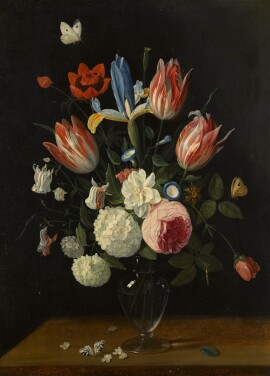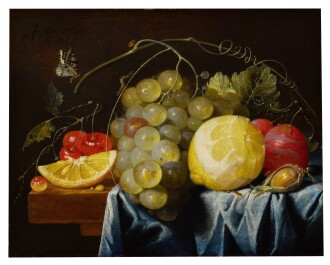T his July we are delighted to present our Old Masters Evening sale, which includes an impressive group of early Netherlandish paintings from a Spanish private collection; masterpieces by some of the finest artists of the late 16th and 17th centuries, such as Jan Brueghel the Elder, Balthasar van der Ast and Ambrosius Bosschaert, many from the collection of the Schuybroek family; and a particularly strong offering of British works from private collections, many fresh to the market, from a hunting scene by John Wootton, to a portrait of the young William IV by Benjamin West, a triple portrait of Emma Hamilton, and a majestic seascape by the greatest British landscapist, J.M.W. Turner. Further highlights include an early, energetic group portrait of the artist Cornelis de Vos and his family by Sir Anthony van Dyck, and a grand still life, in excellent condition, by Willem Kalf.
Tour the Virtual Gallery
Sale Highlights
Tim Marlow at Sotheby’s Summer Season Exhibition

One of the most fascinating aspects of early Netherlandish paintings is the treatment of landscape and some of the first forays into its depiction as an independent genre. The term ‘World Landscape’ was coined to describe the types of compositions that show imaginary, panoramic vistas, usually from an elevated perspective, in which narrative subjects are often found to be secondary to the spectacle of dramatic rock formations, bodies of water, marine vessels, fantastical cityscapes, architecture, and myriad other anecdotal details.
The Antwerp painter Joachim Patinir (1480-1524) is credited as the pioneer of this tradition, though such features are also present in works by artists of the previous generation, such as Rogier van der Weyden (1400-64), harking back to the tradition of manuscript illumination. The early Netherlandish paintings offered in this sale, all from a distinguished Spanish private collection, exemplify the development of this phenomenon – and close observation of the landscape backgrounds affords a breath-taking glimpse into these alternative realities.

This sale offers a high-quality and varied range of still life paintings. A genre that has preoccupied artists for centuries, it provides the opportunity to depict living and inanimate objects for the purposes of both naturalistic observation - sometimes with astonishing realism - and symbolic meaning. The lavish bouquet by Jan Brueghel the Elder represents the earliest Flemish flower still life, painted in 1605, around three years before the exquisite work on copper by Ambrosius Bosschaert the Elder, who was the foremost pioneer of flower painting in The Netherlands. Their approaches differ considerably, though their ambition to depict rare and beautiful blooms as close to nature as possible is shared, and their enduring legacy resonates through the still lifes of Bosschaert’s nephew, Balthasar van der Ast, and Jan van Kessel, later in the century.
Never far from the meticulous rendering of these forms is an allegorical reading of their arrangement – the flowers in full bloom contrasted with those beginning to wilt, and the delicate butterflies and insects all representative of transience and worldly vanity. Vanitas would become an ever more dominant theme, introduced here in the form of exotic, organic curiosities such as the beautiful shells in the paintings of Van der Ast, or more explicitly in the manmade objects found in the monochrome still life by Willem Claesz. Heda, where one of the expensive glass roemers lies shattered and the choice silver tazza has tipped over. Jan Davidsz. de Heem, perhaps the greatest Dutch still life painter of the 17th century, masterfully combined many of these elements into single compositions, even including a skull in one of the small works presented here.
Reflective of this paradoxical taste for depictions of precious, luxurious artefacts on one hand, and moralistic, admonitory messages on the other, is the magnificent pronkstilleven by Willem Kalf, in which the exquisite examples of workmanship are really just as perishable as the cut melon, half-eaten bread, or the single rose beside them.
Elsewhere in Europe the female artist Fede Galizia helped to define still life as a genre in Italy in the early 17th century - specialising in intimate, pared-down compositions that focus on fruit and flowers, in simple but fine receptacles - while Juan de Arellano, inspired by Flemish examples, became the pre-eminent flower painter in 17th-century Spain, where he was frequently commissioned to produce decorative sets of lavish still lifes, of which the canvases in this sale are excellent examples.

“They that go down to the sea in ships, and occupy their business in great waters”
Mankind has been obsessed with the sea and with sea travel for millennia – the line above is from one of the Psalms, not a Victorian tract. Fishing and maritime trade became celebrated in art as soon as the artists of maritime nations had the means to do so, and so of course marine painting was invented by the Dutch, a decade or so after establishing de facto independence from the Spanish Empire. Hendrick Vroom’s painting of fishermen bringing their catch ashore under brooding skies on the North Sea coast at Scheveningen was painted nearby in Haarlem in 1607. Fishing was of crucial importance to the Dutch economy in the 17th Century, and was a key source of wealth, which is why the canny Dutch sent warships to protect their fishing fleet, as nations do to this day.

Lot 31, Hendrick Cornelisz. Vroom, The fishing fleet coming ashore at Scheveningen, their unloaded catch displayed for sale, and a whaler and a man o' war in the offing. Estimate £100,000–150,000.
Lot 32, Willem van de Velde the Elder, A coastal scene with a three-master, a kaag on a broad reach and other small vessels, a penschilderij. Estimate £400,000–600,000.
Lot 50, Joseph Mallord William Turner, R.A., Purfleet and the Essex shore as seen from Long Reach. Estimate £4,000,000–6,000,000.
Lot 49, William Hodges, R.A., View of Port Louis, Mauritius from the sea. Estimate £100,000–150,000.
Willem van de Velde the Elder’s remarkable penschilderij ('pen-painting’) – a technique he pioneered in which the artist draws in pen and black ink on a prepared oak panel – reveals how far marine art had developed in thirty years. Van de Velde celebrates the familiar normality of inshore sea-faring life in his native land – he has let us see exactly what everyone is doing on the small sailing merchant vessel in the foreground, with the skipper bracing himself against the heavy tiller, while fishermen haul in nets in a rowing boat to the right. By now a prosperous nation on the verge of full formal independence, nothing disturbs the tranquility of a normal day’s work.
The 17th-century Dutch may have produced the first world-wide sea-borne Empire – they even discovered Australia, as visitors to the Rijksmuseum are reminded – but the greatest maritime Empire was the one whose apogee came little more than a century ago. Its greatest maritime painter was Turner, who hugely admired the Van de Veldes, and who also was more at home painting the reality of seafaring life, usually – because he was a Romantic – eschewing the calms that Van de Velde liked so much. His Purfleet and the Essex Shore as seen from Long Reach shows us a normal breezy day in the Thames Estuary, with men in a small rowing boat netting fish, exactly as in Van de Velde’s penschilderij of a century and a half earlier. Vroom and Van de Velde were entirely at home on the waters and shores of their native Holland, and Turner was equally at home here. He was born on the banks of the Thames, and often travelled down its estuary to Margate.
William Hodges could not have been more different. He travelled all over India and subsequently the Indian and Pacific Oceans in the company of Captain Cook. It is due to him that we have a detailed visual record of far-flung and still-exotic places, some of which became part of the British Empire, others of which did not. An acute spirit of enquiry runs through all his work, and an uninhibited delight in what he saw. He almost certainly painted this view of Port Louis on the northern coast of the island of Mauritius during his return from India to England via the Cape of Good Hope in 1775. Founded by the Dutch and named after Prince Maurits (an admirer of Vroom), Mauritius was by the 1780s under French control, and named by them Île de France, though an important victualling point for merchant ships of other nations, including the British, who took control of it after the defeat of Napoleon, and gave it back its Dutch name. There is no doubting Hodges’ delight in the scene before his eyes: not just the steep mountains of the Mauritian hinterland, but also in the pattern of clouds on an evidently breezy afternoon, and the theatrical sunlight illuminating the town.























